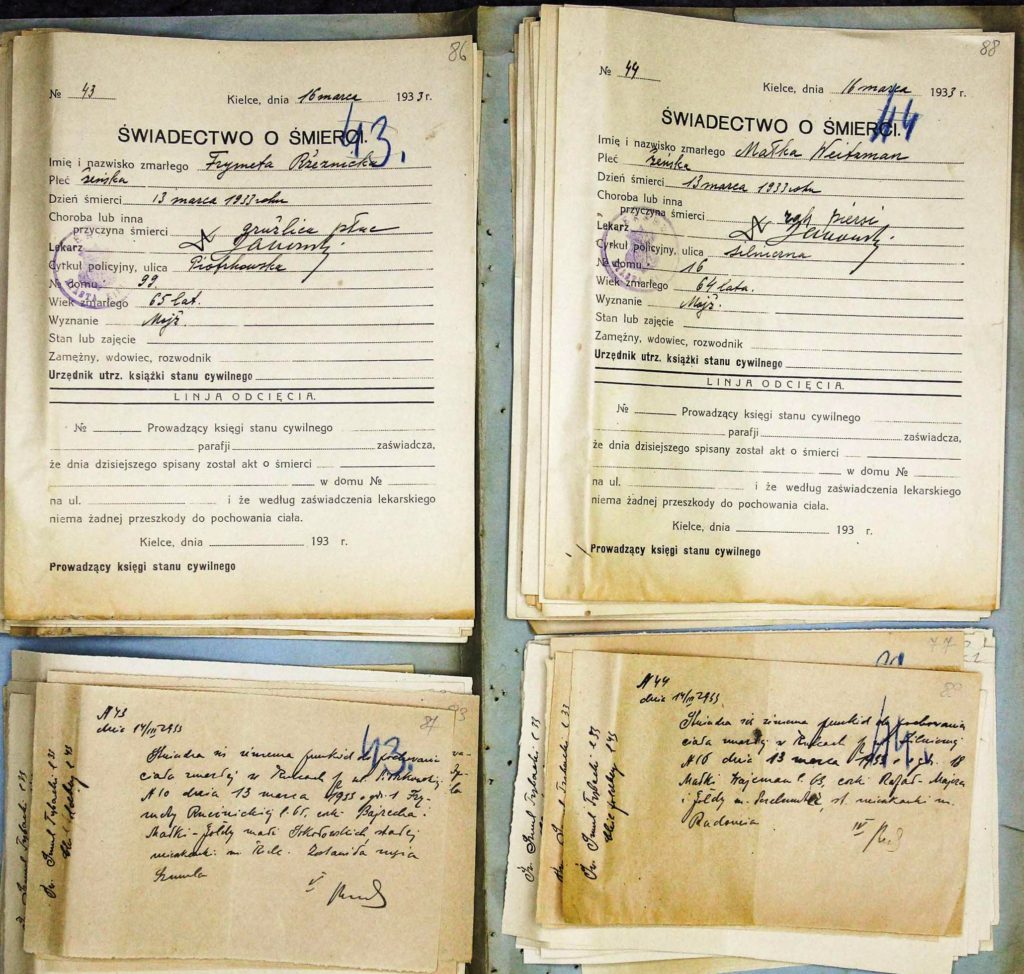Invaluable attachments to 20th century Kielce synagogue district death records
Today is a day when all family historians tracing their roots to Kielce city and area towns will have access to a remarkable collection of a unique data set of the highest professional quality. In this post, I will also be describing the ongoing work of the JRI-Poland Kielce-Radom Research Area team to ensure that all future data we provide meets the same high standards. First, a brief history of the data released today…
On July 5, 2021, Jewish Records Indexing – Poland executive director Stanley Diamond announced the discovery of unusual “hidden in plain sight” record collection with potential benefit for many researchers -the “Attachments to the death certificates of the Kielce Synagogue District” collection with scans of 12,300 cards documenting the 1905 to 1935 deaths in Kielce.
The combination of the pre-printed and handwritten cards with additional information include a treasure of genealogical detail over and above date of death and place of birth, parents’ names, current (street) address and town of permanent residence. Marriage information for the deceased or parents of the deceased is also included in most cards.
Because dedicated researchers answered Stanley’s call for volunteers, on 21 October 2021, I was able to publicly announce the completion of full extraction of these Kielce Death Attachments. And today, I am delighted to reveal that these extracts are fully accessible for online search on the JRI-Poland website.

An unusual resource
The death attachments folder is an unusual resource with two types of documents, a death certificate (Świadectwo O Śmierci) issued by a Kielce doctor with details on a pre-printed form; and a handwritten paper document that acted as an official burial permit attested by the statistical Department of the Kielce Municipal Office. Although signed by the secretary of the Kahal, this was not a synagogue “burial record” since it was initiated and maintained by the Kielce Municipality. The overall function of these documents was to provide vital details used in the process of registering the death event in the civil metric books.
Accuracy above all – what makes our work special
Since the death attachments correspond 1:1 with the vital death registration akt numbers in the civil metric books, we assigned this Akt number to the extract and combined data from both supporting documents. Moreover, as we previously fully extracted the available Kielce metric records, we were able to cross-reference individuals to create the most accurate reading of challenging handwriting. This is an ongoing process – we continuously review our master files and make corrections. From a genealogical standpoint this gives the fullest picture possible of the deceased individual and family and as the Kielce-Radom Research Area Coordinator, meets my personal goal to provide JRI-Poland with the most accurate information for each and every record.
Proprietary value-added information
The death attachment extracts supplement JRI-Poland’s full extraction of all surviving civil records of the city of Kielce from 1868. Going beyond full extraction of vital data, we have devoted countless hours to create value-added fields that are proprietary to contributors wanting to deep dive into their family story and invaluable to researchers wanting to accurately document their research findings. These include links to cemetery tombstones and invaluable deduced surname columns. Even with surnames eradicated from surviving tombstones, with the year of death, given name and father’s name we were able to link a tombstone to a death registration. Sadly, not many tombstones survived desecration. Such linkages and deductions are only possible because we have fully extracted the vital records, created standardized name fields, analyzed clans and deduced missing or changed surnames – while maintaining the integrity of the original deciphered data. Clerks notoriously omitted mother’s maiden names which for many records we have succeeded in deducing and extrapolating.
Family migration
Furthermore, since JRI-Poland has fully extracted vital registrations from all prominent Kielce towns, we are able to trace the migration of families from one town to another and uncover long-standing mysteries for the families of our research community.
JRI-Poland and the Kielce-Radom Research Area records-extraction initiative
JRI-Poland is committed to fully extracting the vital data from all Kielce towns – town by town – resource by resource: Parish records, metric records, Books of Residents, school lists and more. The resourceful and inspired efforts to standardize names facilitates name deductions, fills in blanks and breaks down brick walls. Additionally, this mass of data enables us to analyze pre-1826 mixed Parish civil records and deduce eventual proper surnames from Patronymics. Through professional level extraction of Kielce records and creation of value-added fields, JRI-Poland optimizes ancestry search for Jewish genealogists.
For more information about the Kielce death certificate attachments and all Kielce-Radom record extraction projects, please contact me directly through the JRI-Poland Town page for Kielce..
Judy Golan
JRI-Poland Kielce-Radom-Sandomierz Area Coordinator